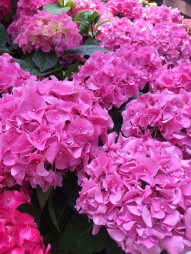Hydrangea
Description
It is hard to miss the stunning blooms of hydrangeas — changing blue in acidic soil, pink in that with more lime. And of course, the white hydrangeas, with blooms resembling large snowballs. The colorful changing flowers is one reason why growing hydrangeas is so much fun. They’re not only easy to grow but are also quite hardy and resistant to most pests and diseases. And with numerous varieties to choose from, you are certain to find one that is right for you. Although there are many types of hydrangeas, most can be grown in full sun or partial shade. Many hydrangeas do not like extremely hot conditions, so try to locate them in an area where they can enjoy some afternoon shade. While they can be grown in a wide range of soils, hydrangeas typically prefer rich, moist soil that drains easily. Amending the soil with compost prior to planting is helpful.
The most common types of hydrangea are the Mopheads and Lace caps. These are the varieties with large, globe-shaped flowers. The Oakleaf hydrangea is another commonly grown variety. With its unique fall color and oakleaf-shaped foliage, this variety usually provides year-round interest. It also tolerates drier conditions. Panicle exhibits white flowers in summer, which gradually turn pink. Water is an important factor when you care for hydrangeas. They enjoy deep watering at least once a week, especially in dry weather. Hydrangeas also benefit from an occasional boost of fertilizer once or twice a year in spring or summer.
Rates
Please contact us for current pricing and availability.


